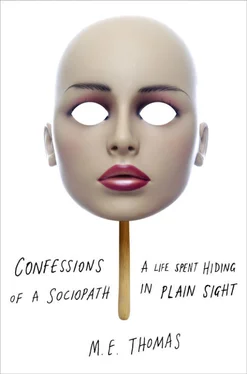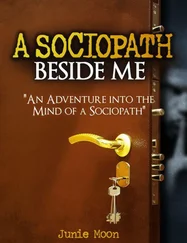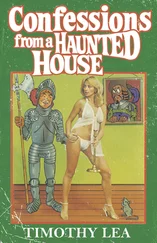Cleckley’s book was widely popular, circulating beyond a purely academic or medical audience. He edited the volume several times, making efforts to create as exhaustive a profile as possible of the modern-day psychopath. Cleckley understood that psychopaths and sociopaths, while sometimes or even often engaged in extremely antisocial acts, could also live lives completely undetected, adapting to their surroundings well enough to pass as normal, even to become contributing members of society.
Because Cleckley realized that there were sociopaths in the world who either do not engage in criminal behavior or are too clever to ever get caught, what began as a study of solely male patients in mental institutions became a much larger volume that included women, adolescents, and people who had never been institutionalized. Many of his later subjects, like Anna, had learned to live relatively normal lives within the general populace. From my own experience, I was sure that, had Cleckley peered into the classrooms of today’s law schools and offices of mega law firms, he would have found plenty of viable test subjects.
Now that I knew that I was not alone, that there were people out there much like me, I wanted to find out more about us.
He gazed upon the mirth around him, as if he could not participate therein. Apparently, the light laughter of the fair only attracted his attention, that he might by a look quell it, and throw fear into those breasts where thoughtlessness reigned. Those who felt this sensation of awe, could not explain whence it arose: some attributed it to the dead grey eye, which, fixing upon the object’s face, did not seem to penetrate, and at one glance to pierce through to the inward workings of the heart; but fell upon the cheek with a leaden ray that weighed upon the skin it could not pass. His peculiarities caused him to be invited to every house; all wished to see him, and those who had been accustomed to violent excitement, and now felt the weight of ennui, were pleased at having something in their presence capable of engaging their attention.
—JOHN WILLIAM POLIDORI,
The Vampyre
In 1819, John William Polidori wrote a novella called The Vampyre , inspired by a fragment by Lord Byron, which would spark a vampire craze across nineteenth-century Europe and influence Bram Stoker and the modern vampire genre. The title character of Polidori’s novella was based on the wayward Byron himself. The vampire enters London high society and beguiles all who cross his path with his mysterious and contrary manners. Accompanying a young gentleman companion southward through Rome and Greece, he seduces and murders young women, unbeknownst to his companion, only to die himself from an apparent murder. A year later, however, the vampire reappears in London, where he seduces and marries his companion’s sister, leaving her drained of blood on her wedding bed.
At once beautiful and treacherous, the vampire occupies the unique position of the appealing monster. He is far from deranged or wild and, in fact, his manners are superior to those of the people he meets. His demeanor is uncanny and yet beguiling, his eyes hollow but intoxicating. His apparent deficits attract his victims and his peculiarities engage them, while he views them as nothing more than objects. The vampire does not seek his lonely existence; he merely lives it out to its fullest measure, unable to function any other way. He drinks blood because it fulfills him; he toys with people because it amuses him. His soul cannot rest.
The gothic vampire is the sociopath writ large, charismatic and sophisticated, a predator walking among us undetected. His myth dates back to the medieval period and is rooted in Slavic spirituality, based on a clear distinction between the body and the soul. An unclean soul gave rise to the vampire, whose continuing existence was both unnatural and interminable.
Sociopaths have been around for a long time, always at the margins. We exist in every culture. According to a 1976 anthropological study by Jane Murphy, members of the Yoruba tribe in Africa called cold souls arankan , “which means a person who always goes his own way regardless of others, who is uncooperative, full of malice, and bullheaded.” The Yupik-speaking Inuit knew antisocial members of their tribe as kunlangeta , of whom it was said “his mind knows what to do but he does not do it”; he is someone who “repeatedly lies and cheats and steals things and … takes sexual advantage of many women—someone who does not pay attention to reprimands and who is always being brought to the elders for punishment.” This concept of an individual who has the mental capacity to understand social norms but refuses to follow them is the key to the clinical diagnosis for modern-day sociopathy.
So, while it’s clear that people like me have existed throughout the many cultures of the world, our modern society likes to apply clear labels to people: Are you a sociopath, or something else? In the science fiction film Blade Runner , the sociopath analogues are the replicants, organic androids who have escaped to Earth and are hunted by Harrison Ford in his nuclear-dusty postapocalyptic world. So human-seeming are the replicants that they can be detected only through a set of emotionally provocative questions. In the movie, Harrison Ford can’t resist the charms of Sean Young’s porcelain skin and perfectly heart-shaped lips, even knowing she is a manufactured thing—that she can feel no empathy despite what he can see in her big, soulful eyes.
I remember watching the movie as a young girl, captivated by Sean Young’s quivering poise and futuristic office attire. Even then I felt sure I could survive pretty well in their harsh world, that all the scattered neon and miscellaneous steam would make it a hard enough place to live that all the weaklings would be relegated to subsistence living, and the strong ones like me would thrive. I imagined wheeling and dealing in pidgin Chinese, darting through alleyways in my dinged-up hovercraft. The irony, of course, is that in my adulthood I would willingly subject myself to very similar diagnostic questions—that I too would be clinically outed by tests designed to measure my lack of humanity.
The Blade Runner example is an interesting comparator because the emphasis is on identification, not diagnosis. The replicants are truly “other” and presumed to be subhuman; therefore there are no ethical constraints on what becomes of them, despite evidence that their internal worlds may have been just as rich as those of the humans. Similarly, even health professionals like Martha Stout, Harvard Medical School faculty member and author of The Sociopath Next Door , speak in terms of “identifying” sociopaths, as opposed to diagnosing. The message seems clear: These people are sociopaths, they aren’t people who have sociopathy. Diagnosis is for people for whom there is a treatment. Because there is no known effective treatment for sociopaths, there is just the question of what to do with the sociopath problem. In Blade Runner , society had come to a definitive decision of what fate would befall its empathy-free creations.
The sociopath problem for our society is, how do we keep sociopaths from acting in antisocial ways? Before society can even begin to discuss solutions to that problem, they need a reliable way to identify sociopaths. Before psychologists can identify them, however, they must be able to understand them. And to be able to understand them, they must be able to identify them. One psychologist has illustrated the tautology in the following way: “Why has this man done these terrible things? Because he is a psychopath. And how do you know that he is a psychopath? Because he has done these terrible things.”
Читать дальше












